Stone Age
Author: Michael Tummelhofer
Publisher: Hans im Glück / Rio Grande Games
Year: 2008
review by

| x |
|
|
|
|
|
|
|
|
|
|
|
|
|
|
|
|
|
|
|
|
|
|
|
|
|
|
|
|
|
|
|
|
|
|
|
|
|
|
|
|
|
|
|
|
|
 |
|
| It was hard labour during the stone age, we just can’t imagine! Happily the illustrator was at the spot and has recorded all the diligence onto the digital cloth for us. This way we are able to see how things went at those times; it resembles a large oldfashioned school education poster that used to hang in front of the black board. We see that our player tribe luckily has settled at a spot where all resources can be found. At the neighbouring lowlands an exubarance of mushrooms, berries, fish and meat can be found, yes, they already enjoyed a balanced meal in those days! |
| x |
 |
|
|
| x |
|
|
|
|
|
|
|
|
|
|
|
|
|
|
|
|
|
|
|
|
|
|
|
|
|
|
|
|
|
|
|
|
|
|
|
|
|
|
|
|
|
|
|
|
|
| Our tribe, at game start numbering only five members, has to deal with various affairs of which the acquiration of resources is the basis and getting food the necessary and essential fuel. The resources are used to proceed on the ladder of civilization: by turning in combinations or quantities of these resources, civilization cards can be acquired that in turn bring more resources or food, but ultimately provide points and end game bonuses. |
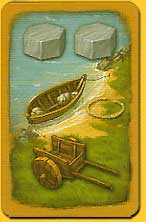 |
x |
 |
|
|
| x |
|
|
|
|
|
|
|
|
|
|
|
|
|
|
|
|
|
|
|
|
|
|
|
|
|
|
|
|
|
|
|
|
|
|
|
|
|
|
|
|
|
|
|
|
|
 |
|
In a turn a player puts one or more of his tribe members on one of the available spots on the board. Only one location may be occupied per turn, and putting additional tokens at this location on a later turn is not allowed. The resource locations all provide space for seven tokens, but in the settlement itself space is scanty: only one or two tokens per location. Also, each of the civilization cards and the huts only provide space for one token. Happily on the lowlands there is ample space to let everybody romp around; there is no restriction to the amount of placed tokens here and this is a good thing as all tribe members have to be fed at the end of each round.
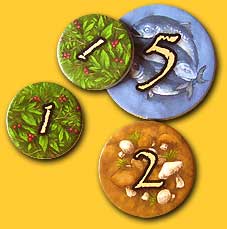 |
|
| x |
|
|
|
|
|
|
|
|
|
|
|
|
|
|
|
|
|
| This condition can be gradually met with some agriculture: place a figure on the grain field and the stock of your imaginary shed is permanently increased by one point, feeding one worker - no more need to find food for him for the rest of the game! The stock in the shed can be increased to up to ten points, the maximum volume of your tribe. Because everybody would like to increase the volume of their grain, the space on the grain field is limited to one - one would think that many hands make light work, but at those times no research of that kind has been initiated, later reports reveal. And also because everybody would like to get relieved from work to do some bees and flowers research in a hut with their girlfriend, this option also is limited: two spaces only, to be filled by two tribe members (you and the girlfriend) of the same tribe. At the end of a round a player may take an extra token from the stock and place it on his player board to be put in action for the next round. |
|
 |
|
| x |
|
|
|
|
|
|
|
|
|
|
|
|
|
|
|
|
|
|
|
|
|
|
|
|
|
|
|
|
|
|
|
|
|
|
|
|
|
|
|
|
|
|
|
|
|
 |
|
|
| x |
|
|
|
|
|
|
|
|
|
|
|
|
|
|
|
|
|
|
|
|
|
|
|
|
|
|
|
|
|
|
|
|
|
|
|
|
|
|
|
|
|
|
|
|
|
| Each player places one or more of his tokens on one of the available spots, and this continues until all tokens have been placed. The starting player now first resolves all his actions on the various locations, thereby introducing a not unimportant attribute of the game: dice! Because chopping trees for wood, hunting for food, or finding gold: who thought this was easy heh? A little uncertainty must be built in: the amount of placed tokens on the location is the amount of dice that may be thrown; the sum of the throw is divided to give the result. On the lowlands this divider is two, in the woods it is three, and so it goes up until gold: divide by six! Taking this into account, it might not be a very clever action placing just one token at a gold location! |
|
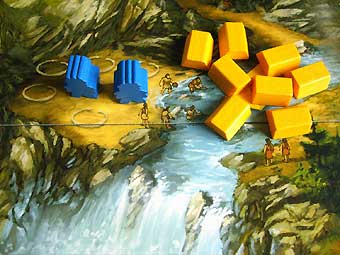 |
|
| x |
|
|
|
|
|
|
|
|
|
|
|
|
|
|
|
|
|
|
|
|
|
|
|
|
|
|
|
|
|
|
|
|
|
|
|
|
|
|
|
|
|
|
|
|
|
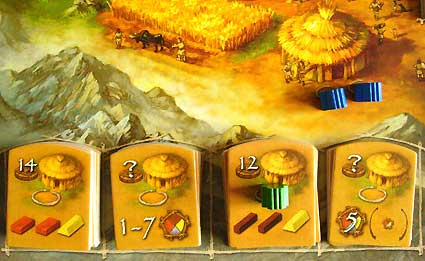 |
|
Happily there is an insurance for this: in the settlement there is a tool workshop. If a player places a token here, he may take an axe with value ‘1’ and place it on his player board. The axes that can be upgraded to three axes with value ‘4’ each may be used to increase the sum of the dice once in a round.
At the same time players could have opted to place tokens on the civilization cards, and on the huts. These can be acquired against their printed resources; the points for te huts are immediately processed on the scoring track. |
|
| x |
|
|
|
|
|
|
|
|
|
|
|
|
|
|
|
|
|
|
|
|
|
|
|
|
|
|
|
|
|
|
|
|
|
|
|
|
|
|
|
|
|
|
|
|
|
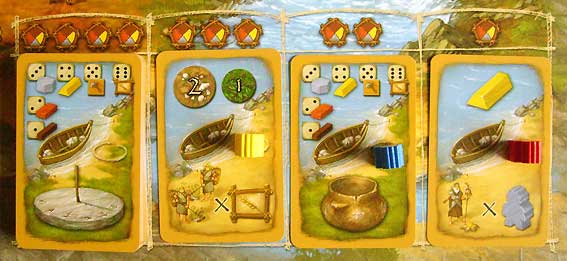 |
|
|
|
|
| x |
|
|
|
|
|
|
|
|
|
|
|
|
|
|
|
|
|
|
|
|
|
|
|
|
|
|
|
|
|
|
|
|
|
|
|
|
|
|
|
|
|
|
|
|
|
| As for the civilization cards, the upper half of these show the revenues; often this is a resource, sometimes food. The lower half shows what end bonus in a certain category will be given. For these bonuses, a player may try to grow a large tribe in combination with a large stock in his grain shed, many huts, or shamans. Ten civilization cards show dice in the upper half, the player buying this card throws as many dice as there are participating players to see what resource he will get. All players after him also may choose from the remaining dice, so everybody is happy! |
|
|
|
|
| x |
|
|
|
|
|
|
|
|
|
|
|
|
|
|
|
|
|
|
|
|
|
|
|
|
|
|
|
|
|
|
|
|
|
|
|
|
|
|
|
|
|
|
|
|
|
 |
|
|
|
|
|
|
| x |
|
|
|
|
|
|
|
|
|
|
|
|
|
|
|
|
|
|
|
|
|
|
|
|
|
|
|
|
|
|
|
|
|
|
|
|
|
|
|
|
|
|
|
|
|
| At the end of a round each player has taken his tokens back to his player board, and a new round starts with the placement of one or more tokens. The game ends when the stack of civilization cards or one of the stacks of huts is depleted. After this, the bonuses are scored to determine the winner. |
|
| x |
|
|
|
|
|
|
|
|
|
|
|
|
|
|
|
|
|
|
|
|
|
|
|
|
|
|
|
|
|
|
|
|
|
|
|
|
|
|
|
|
|
|
|
|
|
| x |
|
|
|
|
|
|
|
|
|
|
|
|
|
|
|
|
|
|
|
|
|
|
|
|
|
|
|
|
|
|
|
|
|
|
|
|
|
|
|
|
|
|
|
|
|
| x |
|
|
|
|
|
|
|
|
|
|
|
|
|
|
|
|
|
|
|
|
|
|
|
|
|
|
|
|
|
|
|
|
|
|
|
|
|
|
|
|
|
|
|
|
|
 |
|
|
|
|
|
|
|
|
|
|
|
|
|
|
|
|
|
|
|
|
|
|
|
|
|
|
|
|
|
|
|
|
|
|
|
|
|
|
|
|
|
| Yes, we have a nice time, and the atmosphere is OK! This mainly is due to the fact that the whole board, and all the elaborate material is so nicely done and contributes to the whole atmosphere, and in fact carries the game: the gold is dug in take away barrels, the clay already comes in bricks and the beautiful illustrations immediately help us to get a warm feeling in this cold stone age! |
|
| x |
|
|
|
|
|
|
|
|
|
|
|
|
|
|
|
|
|
|
|
|
|
|
|
|
|
|
|
|
|
|
|
|
|
|
|
|
|
|
|
|
|
|
|
|
|
 |
|
| x |
|
|
|
|
|
|
|
|
|
|
|
|
|
|
|
|
|
|
|
|
|
|
|
|
|
|
|
|
|
|
|
|
|
|
|
|
|
|
|
|
|
|
|
|
|
The gold coloured grain would not be unbecoming on a poster from former workman times! And we did not even mention the free included veal leathered dice cup - but now we did we can take this away from our to do list!
No one nags us, and all get something, however some less, admitted. You score some points, and I also score some, and so the game ripples on. The various dice throws are a nice element, especially the ones that come with the civilization cards as it brings goodies for each player. |
|
| x |
|
|
|
|
|
|
|
|
|
|
|
|
|
|
|
|
|
|
|
|
|
|
|
|
|
|
|
|
|
|
|
|
|
|
|
|
|
|
|
|
|
|
|
|
|
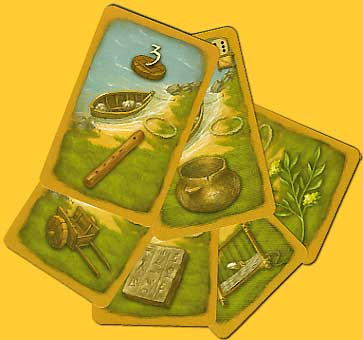 |
|
Of course the neighbouring tribe must be kept an eye on when it collects too many cards with a green background - eight different symbols of these score a whopping 64 points at the end! But each of the players will keep their end up concerning this bonus; all have some category where they score: for grain, or for shamans; this player scores an additional twenty points, another forty, and this way the majority of the players move their score marker a second time along the track. |
|
| x |
|
|
|
|
|
|
|
|
|
|
|
|
|
|
|
|
|
|
|
|
|
|
|
|
|
|
|
|
|
|
|
|
|
|
|
|
|
|
|
|
|
|
|
|
|
| This points galore is a bit over the top; it subtracts from the sharpness of the game. What is wrong with a game that has finished and where we immediately notice the score and thus can see who has won? Why is it that in most present multi layered games it is clear who has won only after the end bonuses have been counted? Such as: ‘Each two jewels also score one point’, ‘Each hundred money scores an additional point’, the detailed and cumbersome hustle with the coat of arms in ‘Louis XIV’, the minus points for not having animals or unplanted fields, and come up with your own example. |
|
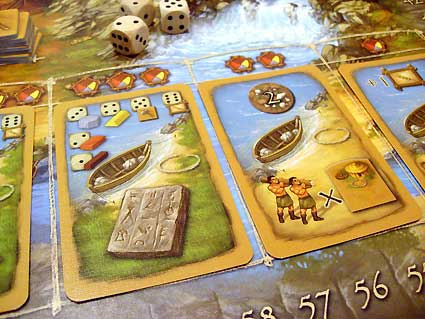 |
|
| x |
|
|
|
|
|
|
|
|
|
|
|
|
|
|
|
|
|
|
|
|
|
|
|
|
|
|
|
|
|
|
|
|
|
|
|
|
|
|
|
|
|
|
|
|
|
The authors and editors in board game land have gone in such a detail that sometimes the victory conditions resemble a supply contract of Gazprom - nothing is left out, and all is worked out in detail. But maybe the focus could be changed back to the main line again: the competition on the board, during the game? As it is now it is too nice, too friendly. Could I get just an ounce of viciousness included, yes please? ‘Stone Age’ certainly is not a bad game, but in lacking the wanted viciousness there is no chance it will be subject to repeated play; and apart from this the game length for what it offers is way too long. © 2008 Richard van Vugt
Stone Age, Michael Tummelhofer, Hans im Glück / Rio Grande Games, 2008 - 2 to 4 players, 10 years and up, 60 to 90 minutes
|
|
  |
Overall execution a 10. What? The box cannot be closed because of the elaborate material? A 10+ then! |
  |
|
|
|
|
|
|
|
|
|
|
|
|
|
|
|
|
|
|
|
|
|
|
|
|
|
|
|
|
|
|
|
|
|
|
|
|
|
|
|
|
|
  |
|
|
|
|
|
|
|
|
|
|
|
|
|
|
|
|
|
|
|
|
|
|
|
|
|
|
|
|
|
|
|
|
|
|
|
|
|
|
|
|
|
  |
Plays nicely! Game length could have been somewhat shorter |
|
  |
That's an 8 with a full point subtraction because of the points galore at game end |
|
| x |
|
|
|
|
|
|
|
|
|
|
|
|
|
|
|
|
|
|
|
|
|
|
|
|
|
|
|
|
|
|
|
|
|
|
|
|
|
|
|
|
|
|
|
|
|
| x |
|
|
|
|
|
|
|
|
|
|
|
|
|
|
|
|
|
|
|
|
|
|
|
|
|
|
|
|
|
|
|
|
|
|
|
|
|
|
|
|
|
|
|
|
|
 |
|
|
|
|
|
|
|
|
|
|
|
|
|
|
|
|
|
|
|
|
|
|
|
|
|
|
|
|
|
|
|
|
|
|
|
|
|
|
|
|
|
 |
|
|
|
|
|
|
|
|
|
|
|
|
|
|
|
|
|
|
|
|
|
|
|
|
|
|
|
|
|
|
|
|
|
|
|
|
|
|
|
|
|
| x |
|
|
|
|
|
|
|
|
|
|
|
|
|
|
|
|
|
|
|
|
|
|
|
|
|
|
|
|
|
|
|
|
|
|
|
|
|
|
|
|
|
|
|
|
|
 |
|
|
|
|
|
|
|
|
|
|
|
|
|
|
|
|
|
|
|
|
|
|
|
|
|
|
|
|
|
|
|
|
|
 |
|
|
|
|
|
|
|
|
|
|
|
|
|
|
|
|
|
|
|
|
|
|
|
|
|
|
|
|
|
|
|
|
|
|
|